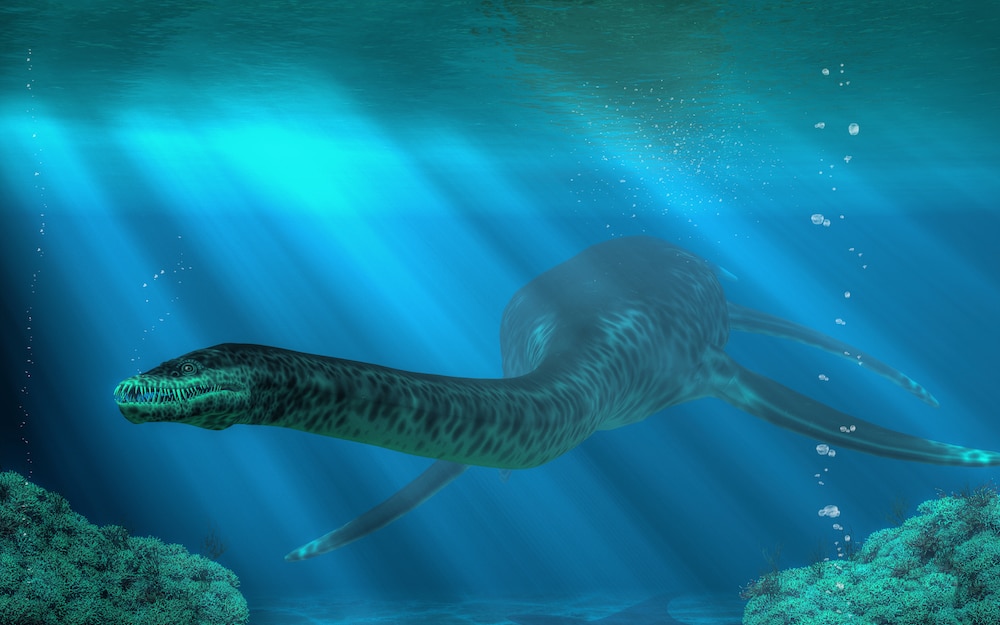Create a free profile to get unlimited access to exclusive videos, sweepstakes, and more!
Prehistoric sea monsters had enormous necks so swimming wouldn’t be a drag
It's a long story.

There was a time when sea monsters were real. Reptilian things with outsize necks slithered through the oceans, snapping up unfortunate prey in their jaws, though they had been long extinct by the time humans started with the shipwreck legends.
Monsters they were, but how could something like a plesiosaur even swim? It was previously assumed that the body shapes of prehistoric marine reptiles allowed them to hunt and compete with other predators. Some, like the Mosasaur that devoured Indominus Rex in Jurassic World: Fallen Kingdom, were built more like sharks or whales. Icthyosaurs were similar to dolphins. Plesiosaurs might have had the most bizarre of body types, with necks that could grow as long as an entire giraffe (up to about 20 feet). That seems as if it would get in the way.
While plesiosaurs weren’t all neck, the morphology of creatures such as Elasmosaurus, which had the longest neck out of all of them, could mean drag held them back when they swam. They still survived for millions of years. Paleobiologist Susana Gutarra Díaz of the University of Bristol, who led a study recently published in Nature, has now found that it was really the size of these leviathans that determined how they moved. Plesiosaurs had apparently evolved huge bodies and flippers that gave them the advantage of almost flying underwater.
“Body morphology reflects evolutionary trade-offs in a diversity of biological functions,” Gutarra Díaz told SYFY WIRE. “Very long necks were likely advantageous for feeding or hunting, but it seems that plesiosaurs could not exploit these advantages until their bodies were large enough to offset the high drag.”
Plesiosaur necks evolved with the rest of their bodies for maximum efficiency. To find out the impact of the size and shape of immense marine creatures, both extinct and extant, on their swimming, Gutarra Díaz and her team ran simulations that were like virtual water tanks. They used modeling software to create 3D models of plesiosaurs, ichthyosaurs, dolphins, and whales, with the extinct species based on actual fossils that had been amazingly preserved. Some of those fossils are nearly complete skeletons. Mosasaurs like the one in Fallen Kingdom weren’t included in the study, but were probably closest to killer whales morphologically.
The models were then loaded them onto computational fluid dynamics (CFD) software that let them “swim” and allowed the researchers to adjust the physical properties of water, such as density, and how it flowed around a given creature. That was how they were able to get an idea of drag and lift that resulted from the body of a plesiosaur or icthyosaur moving through the ocean. They were also able to control morphological factors that influenced movement.
“Because our experiments are all digital, we can easily recreate some hypothetical morphologies,” said Gutarra Díaz. “We can do things like remove the flippers to see how much they contribute to drag, put together different hypothetical combinations of trunk and necks proportions, or even create crazy long necks that don’t exist in nature.”
So if ichthyosaurs and plesiosaurs both swam in the depths, how could they have evolved to be drastically different? Life on Earth started out in a vast ocean. Some prehistoric creatures morphed form marine to terrestrial, and while there were those that stayed on land, some went back. Both plesiosaurs and ichthyosaurs had terrestrial ancestors. It is possible that these ancestors later moved to the ocean, and that their swimming patterns were the evolution of walking patterns that had evolved from living on different types of terrain with various environmental influences.
Unfortunately, the earliest phases of transition from land to water in icthyosaur and plesiosaur relatives are unknown. There are some traces of evidence in the fossil record. The earliest aquatic ancestor of ichthyosaurs, Cartorhynchus, is known to have been a swimmer, but bones that appear as if they belonged to more terrestrial reptiles still elude us. What is obvious is that the unique ways ichthyosaurs and plesiosaurs swam reflect different modes of evolution. An icthyosaur would swim somewhat like a dolphin, while plesiosaurs swam more like sea turtles, but using all four flippers. Gutarra Díaz observed that elasmosaur necks evolved unusually fast.
“Our analysis suggests that the fast change in neck proportions in elasmosaurs might have been favored by their large bodies,” she said. “Their bodies might have released the hydrodynamic constraint on necks and set the conditions for large necks to evolve.”
























